| dc.contributor.author | Gagnon, Karine | |
| dc.contributor.author | Rinde, Eli | |
| dc.contributor.author | Bengil, Elizabeth Grace Tunka | |
| dc.contributor.author | Carugati, Laura | |
| dc.contributor.author | Christianen, Marjolijn J.A. | |
| dc.contributor.author | Danovaro, Roberto | |
| dc.contributor.author | Gambi, Cristina | |
| dc.contributor.author | Govers, Laura L. | |
| dc.contributor.author | Kipson, Silvija | |
| dc.contributor.author | Meysick, Lukas | |
| dc.contributor.author | Pajusalu, Liina | |
| dc.contributor.author | Tüney Kızılkaya, İnci | |
| dc.contributor.author | van de Koppel, Johan | |
| dc.contributor.author | van der Heide, Tjisse | |
| dc.contributor.author | van Katwijk, Marieke M. | |
| dc.contributor.author | Boström, Christoffer | |
| dc.date.accessioned | 2020-07-03T10:43:38Z | |
| dc.date.available | 2020-07-03T10:43:38Z | |
| dc.date.created | 2020-04-28T13:10:54Z | |
| dc.date.issued | 2020 | |
| dc.identifier.citation | Journal of Applied Ecology. 2020, 57 (6), 1161-1179. | en_US |
| dc.identifier.issn | 0021-8901 | |
| dc.identifier.uri | https://hdl.handle.net/11250/2660692 | |
| dc.description.abstract | 1.Vegetated marine and freshwater habitats are being increasingly lost around the world. Habitat restoration is a critical step for conserving these valuable habitats, but new approaches are needed to increase restoration success and ensure their survival. 2.We investigated interactions between plants and bivalves through a review and analysis of 491 studies, determined the effects, mechanisms and key environmental variables involved in and driving positive and negative interactions, and produced guidelines for integrating positive interactions into restoration efforts in different habitats. 3.Fifty per cent of all interactions (both correlative and experimental studies) were positive. These were predominant between epifaunal bivalves and plants in all habitats, and between infaunal bivalves and plants in subtidal habitats. Plants primarily promoted bivalve survival and abundance by providing substrate and shelter, while bivalves promoted plant growth and survival by stabilizing and fertilizing the sediment, and reducing water turbidity. The prevalence of positive interactions increased with water temperature in subtidal habitats, but decreased with water temperature in intertidal habitats. The subset of studies conducted in a restoration context also showed mostly positive interactions. 4.Twenty‐five per cent of all interactions were negative, and these were predominant between plants and infaunal bivalves in intertidal habitats, except sulphide‐metabolizing bivalves, which facilitated plant survival. Interactions involving non‐native species were also mostly negative. 5.Synthesis and applications . Promoting facilitative interactions through plant–bivalve co‐restoration can increase restoration success. The prevalence of positive interactions depends on habitat and environmental conditions such as temperature, and was especially important in subtidal habitats (involving both infaunal and epifaunal bivalves) and in intertidal habitats (involving only epifaunal bivalves). Thus sites and species for co‐restoration must be carefully chosen to maximize the chances of success. If done properly, co‐restoration could increase initial survival, persistence and resilience of foundation species, and promote the recovery of associated biodiversity and ecosystem services. | en_US |
| dc.language.iso | eng | en_US |
| dc.publisher | Wiley | en_US |
| dc.rights | Navngivelse 4.0 Internasjonal | * |
| dc.rights.uri | http://creativecommons.org/licenses/by/4.0/deed.no | * |
| dc.title | Facilitating foundation species: The potential for plant-bivalve interactions to improve habitat restoration success | en_US |
| dc.type | Peer reviewed | en_US |
| dc.type | Journal article | en_US |
| dc.description.version | publishedVersion | en_US |
| dc.rights.holder | © 2020 The Authors | en_US |
| dc.source.pagenumber | 1161-1179 | en_US |
| dc.source.volume | 57 | en_US |
| dc.source.journal | Journal of Applied Ecology | en_US |
| dc.source.issue | 6 | en_US |
| dc.identifier.doi | 10.1111/1365-2664.13605 | |
| dc.identifier.cristin | 1808459 | |
| cristin.ispublished | true | |
| cristin.fulltext | original | |
| cristin.qualitycode | 2 | |

